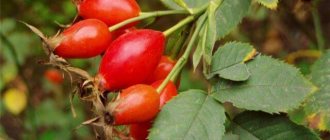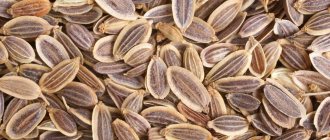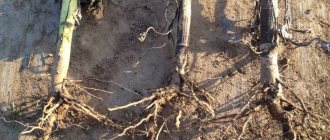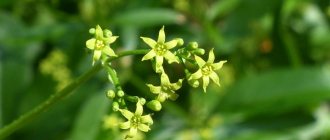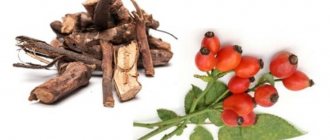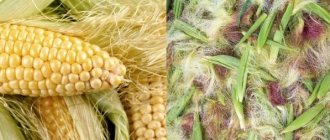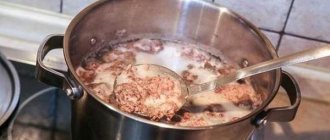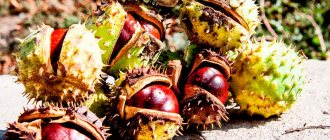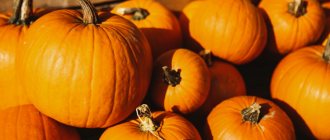Fresh lingonberries rarely appear on store shelves. The plant in our country grows mainly in the Altai Territory. These are not quite ordinary ones, but creeping shrubs with very tenacious and strong branches that can spread over a fairly large area.
Lingonberries bear fruit in the fall: the branches are covered with small bright red berries. Along with the leaves, they have been used by traditional healers for a long time to treat many diseases. Preparations based on lingonberries are beneficial for the kidneys, liver, gastrointestinal tract, heart and blood vessels, and vision. In this article we will talk in detail about the use of the plant to treat various diseases. You will learn which parts of it are most often used in folk and traditional medicine, how to brew lingonberries for the kidneys, and how to take medications based on them.
Are lingonberries always good for you?
Due to their pronounced antiseptic and diuretic properties, medicinal preparations based on lingonberry leaves activate the functioning of the kidneys, in some cases stimulating their cleansing of toxins and mineral deposits. Meanwhile, intensive work of the kidneys and active release of fluid from the body are not always useful, even with their pathologies. For some kidney diseases, remedies from berries and leaves can be dangerous.
For example, lingonberries are often prescribed and successfully used for many forms of pyelonephritis. But in case of renal failure, which is sometimes a consequence of pyelonephritis, its use is prohibited. The same situation is observed if glomerulonephritis is diagnosed, with kidney stones. In these cases, lingonberries are prescribed with caution, in accordance with the patient’s condition, the size of the stones, their location, etc.
With such ambiguity in the effect of the plant, it is necessary to clearly understand how drugs based on it act on the body and on the kidneys in particular. It is important to know what the diagnosed disease is, what pathological processes develop during it, and how the active components of lingonberries can affect diseased organs.
Benefits and harms
The subshrub has many medicinal qualities, which are actively used in modern and folk medicine.
- The beneficial properties of the plant include the treatment of diseases:
- impaired metabolism;
- kidneys and urinary tract;
- diabetes mellitus;
- fever;
- cystitis;
- vitamin deficiency
- Also an evergreen shrub:
- has a diuretic effect on the body;
- performs antipyretic function;
- has antiseptic properties;
- has an astringent function.
Useful properties of the plant
The main and most famous of them is diuretic. Lingonberry leaves and, to a lesser extent, fruits contain a large amount of glycosides: arbutin, hyperoside, vaccinin. When they enter the body, they are converted into hydroquinone, which acts as an irritant to the kidney parenchyma and stimulates the kidneys to secrete fluid. As a result, when using lingonberry preparations, diuresis increases significantly, pathogenic microorganisms, which often cause inflammation, are removed from the kidneys faster.
Another valuable property of the plant is antiseptic. Lingonberry leaves contain a large amount of free benzoic acid, which effectively suppresses pathogenic bacteria in the kidney tubules. Ripe berries contain about 0.2% benzoic acid, which, being absorbed into the stomach, is delivered through the blood to the kidneys and begins the fight against microbes here.
Doctors note the antioxidant effect of the active substances that make up lingonberries - ascorbic acid, flavonoids, quercetin. However, neither the lingonberry leaf nor its berries are superior to other herbal preparations in terms of the severity of this effect, and therefore it would be incorrect to talk about the unique benefits of the plant in this regard.
Traditional healers and herbalists are well aware of the medicinal properties and contraindications of lingonberry leaves. They contain a record amount of vitamins B and C, as well as minerals - calcium and potassium, sodium and phosphorus and others. One cannot ignore the benefits of the anti-inflammatory effect of lingonberry leaves for the kidneys. They have diuretic properties, which are used in the treatment of renal failure, normalization of water balance, and elimination of edema.
Knowing the medicinal properties and contraindications of lingonberry leaves, doctors advise strictly following the prescribed dosage when taking drugs based on them. As a rule, the course lasts 10 days, after which you should take a break for two months.
Lingonberry leaf. Contraindications.
There are few restrictions on lingonberry therapy for renal pathologies; it is even recommended during pregnancy to relieve edema. But before using lingonberry berries or leaves, you should consult your doctor.
Treatment with lingonberries is unacceptable in acute forms of glomerulonephritis and renal failure, because the body, which does not remove decay products with urine, is not cleansed, and intoxication begins.
It is also not recommended for use in case of cholecystitis.
If your blood pressure is below 100/70, you should not drink this tincture or tea, since it contains components that have a vasodilating effect, which leads to an even greater decrease in pressure.
An allergic reaction to lingonberries is rare, but the first time you eat them, you still need to listen to your condition. If signs of allergy are felt, stop eating lingonberries.
Lingonberries should not be consumed if you have stomach or intestinal ulcers, gastritis with high acidity, or if there is a risk of bleeding.
Use caution when treating small children.
If there are contraindications for use, it is better to use other methods of treatment.
Doctors do not recommend eating lingonberries in any form if you have high stomach acidity, as they can cause diarrhea. You should use it carefully in case of hypotension so as not to lower your blood pressure. It is also worth consulting a doctor if urolithiasis is detected, so that lingonberries do not provoke the movement of stones.
Lingonberry leaf is dangerous due to the toxicity of large quantities of arbutin and its derivative into which it is converted in the body - hydroquinone. With approximately the same frequency with which these substances have a therapeutic effect, they also cause undesirable side effects: in mild cases - nausea, vomiting, abdominal pain, diarrhea, malaise, in severe cases - severe poisoning requiring hospitalization of the patient.
In addition, the taste of decoction and tea based on lingonberry leaves is not very pleasant (the products are bitter), which can additionally increase nausea in the patient. Such products have virtually no odor.
Due to the high probability of such poisoning, any preparations based on lingonberry leaves are contraindicated for children under 12 years of age (especially infants!), pregnant women and breastfeeding mothers. In exceptional cases, the doctor allows the drug to be given to the child 1-2 times to obtain a pronounced diuretic effect.
By the way, lingonberry leaf is dangerous for pregnant women because it can tone the muscles of the uterus. This action can cause miscarriage in early pregnancy (mainly in the first weeks) or premature birth in the third trimester. And although the likelihood of such an outcome is much lower than, for example, when using chamomile, it exists and complements the severity of the contraindication of the drug during pregnancy.
Also, lingonberry leaves, due to the content of a large number of biologically active substances, can cause allergies, and sometimes quite severe ones, up to angioedema and anaphylactic shock. Cases of such complications are very rare, but they should be taken into account by those who experience adverse reactions after eating lingonberries, cranberries or blueberries.
Even if lingonberry leaf causes an allergy, it is usually not severe and manifests itself only as a slight rash on the skin.
Finally, some side effects are directly related to the medicinal properties of the leaves and are their “downside”. In particular, these are:
- Reduced blood pressure, dangerous for hypotensive patients. As a result, if you have low blood pressure, you should not take medications with lingonberry leaves;
- Severe pain during exacerbations of cystitis and prostatitis associated with increased urination;
- Deterioration of the condition of patients in whom this or that disease leads to frequent urination;
- Deterioration of the condition of patients with enuresis, in whom manifestations of urinary incontinence increase due to the action of the drug. Consequently, enuresis is also a contraindication for taking lingonberry leaves.
Kidney diseases in different cases can be both indications and contraindications for taking lingonberry leaves.
Thus, you should not take such drugs in case of acute inflammation of the kidneys, the formation of large stones in the kidneys, chronic glomerulonephritis and renal failure in any form.
At the same time, for mild pyelonephritis, a cyst in the kidneys, or the presence of sand in them, lingonberry leaves can be prescribed by a doctor.
Likewise, urolithiasis can also be both an indication and a contraindication for taking lingonberry leaves. If the stones in the bladder are small and can be passed through the ureters, lingonberry preparations may be indicated. If there are large stones, taking such drugs is prohibited.
Finally, lingonberries should not be taken if you have cancer or the risk of developing it. Research shows that arbutin and hydroquinone are carcinogens that, in large quantities, can provoke and accelerate the development of cancerous tumors. Although the results of these studies are not yet entirely clear and additional checks are being carried out, for complete safety if there is a risk of developing cancer, drinking products from lingonberry leaves is not recommended.
Despite the enormous benefits of the plant and its wide range of uses, there are certain prohibitions when taking lingonberries is not recommended. For example, doctors do not recommend the berries and leaves of the medicinal plant to anyone who has high acidity in the stomach, since in such a situation the plant will cause diarrhea.
Hypotonic patients should use the fruits with caution, since their diuretic effects reduce blood pressure. In order not to worsen your condition, you need to consume berries little by little and not use them as a medicine. In case of ICD, lingonberries are used only after consulting a doctor, since its diuretic effect can lead to the displacement of stones.
The berry has contraindications
A dangerous property of the plant is its ability to accumulate radioactive substances. They are dangerous for humans. Therefore, berries and leaves of plants that are located near busy highways cannot be used for medicinal purposes. It is better if the raw materials are collected in the field or forest.
To summarize, we can say that lingonberries are used by adherents of traditional medicine for a number of diseases. It improves immunity, gives energy, and has bactericidal properties.
Its main effect is diuretic, due to which it helps to reduce high blood pressure, overcome swelling, and solve problems with kidney function.
Lingonberry leaf is a unique product; its healing power is practically free of side effects. There are only a few restrictions when taking a medicinal plant:
- individual intolerance to plant components;
- hypotension (low blood pressure);
- cholecystitis;
- history of stomach ulcer or gastritis with high acidity;
- Children under 12 years of age should use with caution.
Preparations containing lingonberry or its components are never taken after meals, only on an empty stomach or at a certain time before meals.
Lingonberry leaves are a unique natural product, indispensable in the fight against many ailments. In this article we learned how lingonberry leaves are useful. How the properties of the plant (diuretic, anti-inflammatory, decongestant, metabolic) are used in practice. When using a plant as a medicinal drug, it is necessary to be guided by reason and not to exceed permissible limits when taking drinks that contain it.
Hypersensitivity. Acute renal failure. Acute gromerulonephritis. Use lingonberry leaves with caution for those who have a tendency to low blood pressure. Also use lingonberry leaf carefully if you have high stomach acidity. Children under 12 years old.
Do not self-medicate. In any case, you need to consult your doctor!
But lingonberry leaves also have contraindications for use. Their use is strictly prohibited:
- with hypotension;
- children under 12 years of age.
In addition, you should drink lingonberry leaf drinks with extreme caution in the following cases:
- heart disease;
- kidney pathology;
- increased acidity of gastric juice;
- long-term use of medications aimed at treating a serious illness.
High sensitivity to the drug, renal failure, glomerulonephritis, age up to 12 years, lactation period, exacerbation of stomach ulcers, urolithiasis. Use with caution in hypotensive patients.
What kidney diseases do lingonberries help with?
The use of leaves and fruits of the plant is effective for acute and chronic inflammation of the kidneys and urinary tract, as well as diseases accompanied by edema and hypertension. These include:
- chronic and acute pyelonephritis;
- urethritis, prostatitis;
- glomerulonephritis;
- cystitis;
- enuresis;
- sand in the kidneys and bladder.
Successful treatment of these serious diseases involves eliminating infection, relieving inflammation and pain, removing excess fluid from swelling and normalizing blood pressure. In addition, efforts should be aimed at normalizing metabolism and increasing the body's resistance. Decoctions of lingonberry leaves meet these requirements. They are prescribed for many nephrological diseases. They eliminate inflammation and relieve unpleasant symptoms.
It is worth noting that when treating the listed diseases, herbalists use lingonberries most often in combinations with other medicinal plants. This can be explained by the fact that the medicinal properties of one plant are greatly enhanced by interaction with other components, and therefore the effectiveness of treatment increases. Lingonberries can be used to treat kidneys in patients of different age groups: children, expectant mothers, and the elderly.
Inflammatory kidney diseases
In case of inflammatory processes in the kidneys, it is very important to establish the cause of the disease. If the pathology is caused by an infection and it affects the tubular system (pyelonephritis), lingonberry preparations can be used in complex treatment as an additional remedy. If the inflammatory process is caused by pathological autoimmune processes and has led to kidney failure, taking lingonberries is contraindicated in most cases.
If pyelonephritis of an infectious nature is diagnosed, folk remedies based on lingonberries for the kidneys can be used in complex therapy. We will tell you further how to drink them and how to cook them.
Juice
It is used as an adjunct to the main treatment for kidney inflammation. Lingonberries are crushed with a blender or passed through a meat grinder, the juice is carefully squeezed out, grinding the crushed berries through a sieve. Before use, it is half diluted with water and natural honey is added. Take a pleasant and healthy drink, 50 ml three times a day before meals.
Is it possible to use lingonberries to get rid of kidney stones?
In nephrology, lingonberries are considered only as a preventive measure for the formation of kidney stones. Its regular use ensures the active removal of fluid and tiny mineral particles. This prevents the formation of sand and then the formation of stones.
Traditional healers claim that lingonberries are capable of dissolving large stones. However, there is no experimental or factual evidence of this fact yet. But cases of exacerbation of the disease, which are associated with the movement of stones and blockage of the ureters, are well known to doctors. For this reason, you should not try to get rid of stones yourself using lingonberries. It's really dangerous. If nephrolithiasis is suspected, it is necessary to undergo a serious examination at a medical institution and consult with qualified nephrologists. After studying his test results, the doctor prescribes treatment. Complex therapy may also include folk remedies, but they must be approved by a doctor.
To prevent the formation of kidney stones, lingonberries are used to make drugs according to folk recipes.
Recipes
The use of lingonberries for the treatment of nephrological diseases has virtually no contraindications, and any herbal decoction or medicine based on natural extracts certainly includes lingonberries.
When using decoctions, fruit drinks and juices, you need to know that alternative medicine requires a systematic approach. Therefore, hoping for complete relief from the disease, you need to complete the course completely.
But do not exceed the dosage indicated in the recipe. Despite the fact that natural medicines are not drugs in the full sense of the word, the concentration of many substances in them is quite high, so their excess can negatively affect well-being. This is especially true for nephrological diseases that can cause temporary or persistent kidney failure.
Lingonberry, and especially its leaves, are a diuretic. Therefore, you should not drink decoctions and fruit drinks before bed.
Tincture
To prepare such a remedy you will need lingonberry leaves; you can also use grass with stems, but without berries (100 g). The raw materials are dipped into boiling water (2.5 l) and almost immediately removed from the heat. The composition is infused for two to three hours, after which it is once again brought to a boil and turned off. After this, 200 ml of high-quality vodka is added to it. Store the product in a dark place in a tightly closed container. Take 20 drops three times a day before meals. Treatment can last from two to four weeks. The decision on its duration is made by the doctor. It depends on the course of the disease and the condition of the patient.
Features of preparing and drinking drinks
Each herbal drink has its own method of preparation. Application may be different: before or after meals, the number of doses per day and the time period may also fluctuate. However, there are general rules:
- Herbal or berry tea is prepared by pouring 200 ml boiling water per 1 tsp. raw materials. Infusion time is from 15 to 30 minutes.
- The herbal mixture can either be brewed in a thermos (not metal) or boiled for half an hour. A mandatory point when preparing herbal infusions is to infuse them for about 1 hour.
Did you know? In Scandinavia during the 19th century. many poor people used boiled potatoes and lingonberries as their main food. Potatoes were not difficult to grow, and lingonberries grew throughout the forest.
It must be remembered that even seemingly harmless herbal infusions should be taken on the advice of a doctor. Only he will be able to determine the required dosage for each individual case.
Morse
If you have sand or small stones, this drink is good for your kidneys. Lingonberry juice is prepared simply: the juice is squeezed out of the berries. A quarter glass is diluted with 150 ml of water. Take a glass a quarter of an hour before meals. It is noteworthy that the period of consumption of this pleasant and healthy drink is almost unlimited. It can also be given to children. If desired, the taste can be improved with a spoon of honey.
Treatment of kidney cysts
It should be noted right away that lingonberries for kidneys with cystic formation are effective only if they are small in size. In addition, improvement in the condition can only be achieved if the pathology occurs without pronounced symptoms. In the acute course of the disease, when the size of the cyst is too large, treatment with folk remedies is inappropriate - it will not bring the desired result, and time will be lost. In this case, surgery cannot be avoided.
For kidney diseases, lingonberries, as we have already said, are used as an additional remedy to the main therapy. For cystic formation, tea made from the berries and leaves of the plant is effective. It is prepared from a teaspoon of dry raw materials, which is brewed with a glass of boiling water and left for a quarter of an hour. They drink it 4-5 times a day.
By eliminating excess proteins and minerals in the urine, this tea is believed to prevent material from accumulating in the cyst and slow its growth.
How to distinguish lingonberry leaves from cranberry and bearberry leaves
Lingonberry leaves, both fresh and dried, can be confused with bearberry leaves and cranberry leaves. Moreover, if the lingonberry bush itself is quite easily distinguished from the cranberry bush, then distinguishing lingonberries from bearberries is much more difficult.
The lingonberry leaf differs from the bearberry leaf in two characteristic features:
- Dark dots on the underside - bearberry does not have them. This is the most obvious difference;
- Pinnate venation - if in lingonberry only the main vein and lateral veins of the first and second orders are clearly visible on the surface of the leaf, then in bearberry with reticulate venation a random network of veins on the surface of the leaf is clearly visible. This difference is most clearly manifested in leaves that are freshly picked or on the bush.
The bearberry bushes themselves are more squat than lingonberry bushes, and usually cover the ground with a continuous carpet, and its shoots do not rise too high above the ground. Its leaves are located on the shoots much more densely, and therefore the bearberry bushes seem like green pillows, in contrast to the lingonberry bushes, which look exactly like small bushes.
Bearberry in its natural habitat - mountain tundra on a rocky slope, where it is not shaded by any other plants.
Cranberry bushes are even lower than bearberry bushes, since all its shoots, even quite long ones, spread along the ground. Cranberry leaves are much smaller than lingonberry leaves - their normal length is 0.6-1.5 cm, and their normal width is 1-6 mm. Considering that cranberries are larger than lingonberries, they turn out to be larger than the leaves on their own bush, while lingonberries are approximately the same size as the leaves.
cranberry bush
For reference: the price of 50 g of lingonberry leaves is about 50-60 rubles. The same amount of bearberry raw material costs approximately 80-90 rubles.
Bearberry is considered a more scarce product, and therefore costs more than lingonberries.
Kidney cleansing
Due to its antiseptic and diuretic effect on the kidneys, lingonberries are used to effectively cleanse them of toxins, excess mucus, microbes, inflammatory products, and harmful substances that the body eliminates through these organs. Periodic cleansing of the kidneys, including lingonberries, is considered a useful health procedure. However, such a procedure, carried out independently, without prior consultation with a doctor, can lead to the movement of large stones that can block the ureters. In this case, urgent surgery will be required.
If your doctor approves the cleansing, then you will need three kilograms of lingonberries. Every day they should be consumed 200 g without sugar, honey or other additives in one of the intervals between meals. During the procedure, fried, smoked, salty foods, processed foods and alcoholic beverages should be excluded from the diet.
Lingonberries for the kidneys: recipes for complex preparations
Traditional healers and many doctors often use in their practice compositions in which lingonberries are one of the main components. Often, for buds, lingonberry leaves are used in combination with bearberry, which has similar properties. The following recipes are common in folk medicine: take five parts of lingonberry seeds, one part each of its dry leaves, nettle, and birch leaves. Mix the ingredients thoroughly, and then brew a spoonful (tablespoon) of the mixture with boiling water (200 ml) and leave until it cools. Take the remedy for inflammation, to prevent nephrolithiasis, ½ cup four times a day for a month.
You need to mix three tablespoons each of lingonberry leaves, bearberry leaves, sage herb, dandelion root, string grass and horsetail. This mixture is poured with a liter of boiling water and left for 12 hours. Take the composition 1/4 cup up to eight times a day. This remedy is effective for kidney inflammation.
For chronic diseases, to prevent relapses, it is recommended to use a decoction of lingonberries and beets. To prepare it, you need to boil a kilogram of each separately. The berries are brought to a boil in a liter of water over low heat, and the root vegetable, previously peeled and chopped, is boiled in the same amount of water for 10 minutes. The decoctions are mixed and honey or sugar is added to taste. Take a glass a day for two weeks. Then you should take a break for two months.
Another effective way to prepare lingonberries. For kidneys, you can use lingonberry water for preventive purposes. To prepare it you will need a glass of fresh berries. They are poured with boiling water (500 ml). The product is infused for six hours. Lingonberry water is a general tonic, and therefore it is advisable to use it in winter to support the immune system. In addition, it lowers blood sugar levels.
Lingonberry leaf. Application.
Many centuries ago, folk healers noted what and what diseases lingonberry leaves help with:
- urolithiasis, gout, removal of salts from the kidneys;
- lesions of the intervertebral discs (osteochondrosis);
- inflammation of the prostate gland (prostatitis);
- treatment of ulcers and other lesions of the mucous membrane from stomatitis and gingivitis;
- therapy of rheumatic conditions;
- therapy for inflammatory kidney diseases (pyelonephritis);
- bladder dysfunction (cystitis);
- therapy of hypertension;
- reducing swelling and strengthening the walls of blood vessels;
- diabetes therapy, lowers blood sugar levels;
- as a remedy for parasitic infections;
- elimination of the consequences of vitamin deficiency;
- diseases of the throat, upper respiratory tract;
- treatment of colds.
You can brew lingonberry leaves in different ways, depending on what goals are being pursued and what disease they want to cure. Let's look at how to brew lingonberry leaves correctly below.
To prepare tea, you will need 1 teaspoon of dried material, pour 200 ml of boiling water, let the drink brew for 15 minutes, strain, and you can drink. If desired, you can add honey to the tea.
- To maintain the immune system, get a boost of energy and strength, drink 100 ml of tea after meals, it is acceptable to take it 2-3 times a day.
- For hypertension - 150 ml of tea throughout the day, after meals.
A favorite way to prepare the drink is tea from lingonberry leaves; its benefits include an invigorating effect on the body and strengthening the immune system, and if you remember the contraindications, you will not be able to harm your health.
To prepare the decoction, pour 1 glass of boiling water into a container with 1 tablespoon of dried material, cover with a lid and cook over low heat for half an hour. The broth cools, it is passed through a filter and used according to the doctor’s prescription.
- For cystitis and other diseases of the urinary system, a decoction of lingonberry leaves is usually drunk 100 ml three times a day, half an hour after meals. Arbutin, which is contained in the leaves of the plant, helps to quickly get rid of pathogenic microorganisms, and relief comes quickly.
- For kidney inflammation - 1 teaspoon of lingonberry leaf and 1 teaspoon of coltsfoot are poured into 400 ml of boiling water, stirring over low heat, simmer for 5 minutes. Cool. Take 100 ml three times a day an hour before meals.
- For colds - three times a day, half an hour after eating, drink 2 tablespoons of the decoction.
- Lingonberry leaves are successfully used for swelling during pregnancy. To obtain a decoction, take 1 teaspoon of leaves, add 200 ml of cold water, bring to a boil and simmer over low heat for 12 minutes. The liquid is cooled. Take 100 ml 20 minutes before meals 2 times a day. It is advisable to repeat the procedure every other day or according to the scheme suggested by the attending physician.
To prepare the infusion, it is best to use a thermos, as it retains heat for the longest possible time. Pour 2 tablespoons of dried leaf into a container and pour 0.5 liters of boiling water, screw on the lid and set aside for 5 hours.
- For inflamed joints, gout, rheumatism, take 100 ml of infusion at regular intervals four times a day.
- To relieve the symptoms of diabetes - 50 ml of infusion three times a day before meals.
- For kidney stones. Brew 1 teaspoon of dried material and 100 ml of boiling water in a thermos and leave for 3 hours. Take 2 tablespoons every 4 hours.
- When using the infusion instead of hair conditioner, the hair will become silky, soft, manageable, while hair loss will decrease and dandruff will disappear.
It is very effective to use lingonberry leaves to treat many bacterial infections (including staphylococcal infections), a local decoction of the leaves is used for throat diseases, stomatitis, periodontal disease, tonsillitis, it is good to use it in the treatment of kidneys, bladder, and diseases of the gastrointestinal tract, for diabetes mellitus, for the treatment of arthritis, for rheumatism, for gallstone disease, for relieving edema (including in pregnant women), for diseases associated with metabolic disorders.
Lingonberry leaf during pregnancy and lactation - there are no contraindications for use, but always be very attentive to your health, consult your doctor. Be sure to take breaks from your courses.
Very often, doctors prescribe lingonberry leaves to relieve swelling in pregnant women and diabetes mellitus in pregnant women. In any case, we are talking about the health of the mother and the unborn child, and here a doctor’s consultation is needed. It should be taken only as directed and under the supervision of a physician, like all medications.
The main application of lingonberry leaves is the treatment of inflammatory diseases of the urinary tract. Preparations based on this raw material are mainly used for cystitis, urethritis, some forms of pyelonephritis, and in men for prostatitis. In all these cases, with increased diuresis, a large number of pathogenic microorganisms, their metabolic products (including toxins), decay products of damaged cells and products of inflammatory reactions are evacuated from the urinary system.
Pyelonephritis on x-ray
Also, due to the diuretic effect, products based on lingonberry leaves are used to treat:
- Edema, primarily swelling of the legs - by removing excess fluid from the tissues, such drugs reduce the severity of symptoms of edema, but do not eliminate its cause. For this reason, some swelling - Quincke's edema, swelling under the eyes - cannot be eliminated with the help of such means;
- Gout - it is believed that due to increased diuresis, excess salts and acids are removed from the body, leading to the disease itself. This version is not confirmed by reliable research, and therefore, for appropriate purposes, drugs are taken only in folk medicine;
- Diseases of the joints associated with metabolic disorders - arthritis, osteochondrosis. The validity of such treatment is the same as for gout - theoretically, the remedy can have a beneficial effect, but in fact its effectiveness is not known;
- Certain kidney diseases that require the presence of anti-inflammatory components and increased urine production, including the formation of cysts. In this case, only a doctor can prescribe lingonberry preparation, since such drugs are contraindicated for some kidney diseases;
- Diseases accompanied by febrile syndrome and increased temperature. Presumably, increased diuresis helps remove a large number of toxins and inflammatory reaction products from the body, due to which antipyretics taken in parallel act stronger and longer. In addition, thirst itself during diuresis and the consumption of increased amounts of fluid stabilizes the temperature and enhances the effect of antipyretics. Lingonberry preparations by themselves do not lower the temperature;
- Diabetes mellitus - again, presumably, increased urination helps remove some free sugars from the blood;
- Hydrocephalus - used very rarely due to high risks for the child.
Due to the diuretic effect, they are also trying to use lingonberry leaves for weight loss in order to “dry” the body, reduce the amount of fluid in the tissues and reduce weight. This approach cannot be considered justified, since the bulk of the body is not determined by the amount of water in the tissues, and temporary removal of part of it will not give any significant effect. There is no guaranteed way to lose weight using lingonberry remedies.
In folk medicine, other indications for the use of lingonberry leaves are known. For example this:
- Pancreatitis;
- Mastopathy (perhaps its use is justified by the same diuretic effect);
- ARVI, bronchitis, and also cough separately as a symptom. It is believed that due to its anti-inflammatory effect, the drug will reduce the severity of the symptoms of the disease and the cough itself;
- Gastritis - mainly due to the astringent effect of the product;
- Thrush - in this case, they rely on antifungal activity, which has not been confirmed or proven. As a result, there are no known cases of curing candidiasis with lingonberry preparations;
- Sore throat, in which lingonberry preparations are used as a gargle and are expected to have an anti-inflammatory and antibacterial effect;
- Hemorrhoids - sometimes enemas and baths with lingonberry decoction are given for it;
- Gallstone disease, in which a choleretic effect is relied upon. However, this application is doubly ambiguous. On the one hand, the choleretic properties of lingonberries have not been proven, on the other hand, even if they exist, the movement of large stones in the gall bladder can lead to obstruction of the bile ducts and serious consequences. Therefore, in these cases, only a doctor who is responsible for the consequences of treatment can prescribe lingonberries;
- Various digestive disorders;
- Inflammatory skin diseases - acne, pimples, psoriasis, dermatitis - mainly based on the anti-inflammatory effect of the drug.
Before using lingonberries in such cases, a professional diagnosis of the disease by a dermatovenerologist is required.
It is dangerous to treat these diseases on your own with lingonberry leaves because refusal of full-fledged pharmaceutical treatment can lead to a worsening of the patient’s condition, and there are no guarantees that the lingonberry drug will help.
Lingonberries are also used in cosmetology due to the ability of arbutin to reduce the severity of age spots on the face. In skin cells, this substance blocks the activity of the enzyme tyrosinase, which is necessary for the production of melanin. As a result, natural lightening of the skin (and, according to some sources, hair) occurs, but this requires taking lingonberry preparations internally, since this effect is very weak when applied externally. Systemic use can lead to undesirable effects, more critical than age spots.
Procurement of raw materials
Lingonberry leaves are harvested in the spring - from late April to mid-May, before the plant begins to flower, while there are no buds on the bushes or while they are very small and green. During this period, the leaves contain the greatest amount of useful substances. You can also harvest leaves in the fall, when fruiting is completed. They are collected even in winter. This is due to the fact that at this time the leaves contain the least moisture, and therefore they dry quickly. When harvesting leaves, it is recommended to cut the shoots with scissors, since the rhizome of the shrub lies shallow - only 2-4 cm.
After drying, it is advisable to separate the leaves from the stems. To ensure that the lingonberry bush does not suffer from the collection of raw materials, repeated harvesting in one place can be carried out no earlier than after five years. Leaves should not be collected during flowering - this will cause significant harm to the plant.
Dry the collected raw materials in warm, well-ventilated and dark rooms. It must be stirred frequently. Dried leaves should remain green. Store them in glass containers or paper bags.
Lingonberries are also prepared for future use. Due to the high content of benzoic acid, they last for a long time. They can be stored in water or weak sugar syrup.
Brusniver for edema
Lingonberry leaves are an equally common remedy for treating edema and infections of the genitourinary system. The preparation of decoctions and infusions from them is described in detail here. Lingonberry leaves are available in pharmacies in the form of crushed dried raw materials in packages and in the composition of special diuretic and urological preparations (Brusniver).
TAGS: swelling
WE RECOMMEND:
- Lingonberry against edema during pregnancy Traditional medicine considers this plant one of the most useful plants, and older people will prefer treatment with this berry to modern drugs. Also…
- Soaked lingonberries The harvest of lingonberries is harvested for future use in the summer. But what to do if there is a lot of jam and syrup in the cellar? Prepare delicious pickled lingonberries!…
Contraindications to the use of lingonberries
We talked a lot about the beneficial properties of lingonberries: how to take its leaves and berries, what is the duration of treatment. It is equally important to know when it is better to stop using this medicinal plant or minimize the use of drugs based on it, carefully monitoring your body’s reaction. Doctors believe that lingonberries should not be used for:
- Stomach ulcers and hyperacidity. Even when taking lingonberries in minimal quantities, it is better to do so after meals. Taking lingonberries on an empty stomach is prohibited.
- Hypotension (low blood pressure). Lingonberries lower blood pressure. The condition of a hypotensive patient can worsen sharply.
- If there is internal bleeding, especially before surgery. Lingonberries are known to thin the blood. During the treatment of urolithiasis, the combination of lingonberries with other drugs is possible only after consultation with a doctor.
Using berries to eliminate swelling
Several components of lingonberries have a beneficial effect on the urinary system. Drinking fresh drinks or drinks prepared from fruits is effective in combating cystitis, pyelonephritis, urolithiasis and excess salts and water in the body. The berries have a mild antispasmodic effect and an antiseptic effect. The contained salicylic acid thins the blood, vitamins C and E, flavonoids strengthen the walls and improve the elasticity of blood vessels. Improving blood flow and establishing normal water-salt metabolism helps eliminate toxins and relieve swelling.
Let's sum it up
When treating kidney diseases with lingonberries or infusions that contain the leaves or berries of the plant, it is important to evaluate the role of herbal medicine for each specific case. It can be presented in equal parts with medications or be auxiliary, becoming a useful addition to the main therapy, enhancing the effect of drugs and accelerating recovery.
Considering the serious consequences that can result from improper treatment of kidney diseases (dialysis, renal failure), do not overestimate the capabilities of herbal medicine. Treatment should be carried out in collaboration with a doctor. Only in this case, the healing properties of lingonberries will help defeat the disease more quickly.
How to make medicine from lingonberry leaves
Medicines for oral administration are prepared on the basis of lingonberry leaves - decoction, tea, infusion of water and tincture of vodka or alcohol.
The most common remedy based on lingonberry leaves is a decoction. To prepare it, boil 2 tablespoons of leaves in 0.5 liters of water for 5-10 minutes, then allow it to cool to room temperature and take 1 tablespoon 3-4 times a day to enhance diuresis and treat cystitis. If necessary, you can brew it in a thermos and keep it longer - in this case it will be more saturated.
As a remedy for rheumatism in folk medicine, it is recommended to prepare a decoction of fresh leaves. Its recipe is similar to the previous one, but the leaves are taken fresh. The finished drug is taken half a glass 2 to 4 times a day for 1-2 months.
Lingonberry tea can be prepared in the same way as regular green tea, but it is dried lingonberry leaves that are brewed. For this, you can also use leaf in filter bags - this is more convenient and practical, since the raw material then does not need to be removed from the drink itself.
Many consumers are skeptical about lingonberries in filter bags, since in this form it is difficult to control the quality of the raw material.
Lingonberry water infusion is prepared according to the following recipe: pouring 5 g of dried leaves (1 tablespoon) with a glass of water at room temperature and then infusing for 8-10 hours. After this, the infusion is filtered and drunk in the same way as a decoction.
To prepare an alcohol tincture, two tablespoons of dried leaves are poured with a glass of vodka or alcohol diluted with water in a 1:1 ratio. Then the vessel with the solution is closed and placed in a dark, cool place for 12-14 days. After infusion, the tincture is filtered and used for treatment. It is important to do this correctly, since the presence of alcohol in the tincture causes additional side effects.
Finally, lingonberry leaf is often added to various herbal mixtures - diuretic, renal, antifungal - in which it is prepared and used. For example, it is often mixed with chamomile, bear ears, cinquefoil, rose hips, blueberry leaves, dried hawthorn berries, horsetail, and strawberries.
One of the complex herbal mixtures containing lingonberry leaf.
Some drug manufacturers produce medications with lingonberry leaves. Among them the most famous are:
- Dilectin;
- Fitolux;
- Procystal, which also includes nettle leaves;
- Pharmatsvet;
- Canephron;
- Homeopathic medicine “GF lingonberry leaves”.
Also, some manufacturers produce lingonberry leaves themselves, packaged in filter bags. The most widely available products in pharmacies are from:
Preparations based on lingonberry leaves are either taken orally or used for local tissue treatment: lubricating the skin, rinsing the mouth or throat.
Instructions for using a particular product depend on the purpose for which it is taken. So, to treat cystitis, drink a decoction or infusion of the leaves three times a day, and to treat rheumatism - half a glass with the same frequency. For sore throat or pharyngitis, gargle with the decoction 3-5 times a day, and to reduce the severity of age spots on the face, wash your face or make masks using gauze soaked in the decoction.
Arbutin itself, already isolated from the leaves, is used in a huge number of cosmetics designed specifically to eliminate age spots.
All leaf-based products are taken orally after meals to reduce the risk of nausea and vomiting. The drugs can be used externally regardless of meals.
Specific instructions for using the product should be given by the doctor who diagnosed the disease, determined its severity and decided to take lingonberries. Without understanding the etiology of the disease and the principle of action of the drug, prescribing dosages and timing yourself at home can be dangerous.
It is important to remember that preparations based on lingonberry leaves should not be taken for a long time, more than a few weeks, since such long-term use is fraught with overdose, hydroquinone poisoning and the development of cancer. For this reason, lingonberry leaves cannot be brewed and used instead of tea constantly - they are taken even in the form of decoctions for a very limited time and only as medicine. As soon as the opportunity to refuse to take lingonberry leaves arises, such treatment should be abandoned.
As a result, lingonberry leaves are a valuable medicinal raw material, successfully used for many diseases, and products based on them provide pronounced therapeutic effects. However, due to serious side effects, they should be taken very carefully, only as directed by a doctor and only for as long as needed to treat the disease.
Lingonberry fruits rank first in folk medicine as a medicine that has a diuretic effect. They are rich in vitamins B, C, E. One berry contains a considerable amount of iron, phosphorus, potassium, citric acid, pectin, carotene. This fruit is useful to take in any form for gout, cystitis and other kidney diseases. Lingonberry leaves have the greatest effect.
